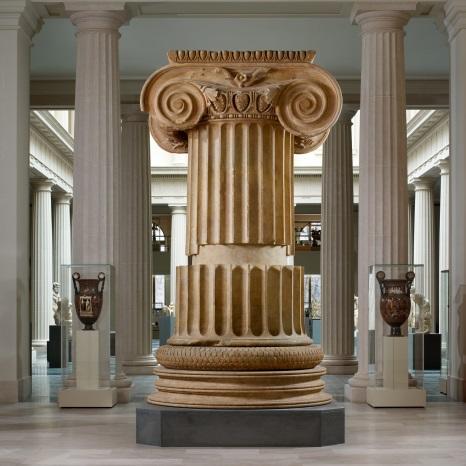
The artifact that was selected for this reflection is the marble column from the Temple of Artemis at Sardis which can be found at the following link. It is originated from the Hellenistic period (300 B.C.). It is an iconic example of the Ionic order column which graced the Ancient Greek buildings. At its full height, the column would have been around fifty-eight feet high. The measurements suggest that this was a column from the porches or inner rooms of the famed temple (The Met, 2017).
The Temple of Artemis was constructed by the architect Hermogenes which emphasized the rules of symmetry and proportionality in the columns. Anionic order column stands on a base that allows its circumference to be more slender than other styles. Most have a standard of 24 flutes in the shaft. The entablature which the columns support is split into an architrave with three bands, a cornice, and a frieze.
The capital is specifically distinctive on the Ionic order. It features symmetrical volutes protruding on each side. In between, there is three-dimensional molding with an egg-and-dart design done in bas-relief. It is suggested that Ionic order columns take their aesthetic inspiration from female physical attributes compared to a more stout and plain structure of the male-inspired Doric columns. They became popular in Ancient Greece during a given period, as they provided a middle ground between the simplicity of Doric columns and the complexity of the Corinthian order. (“Ionic Order,” n.d.).
The Longworth House Office building built in the first half of the 20th century is an example of the ongoing influence of Hellenistic architecture. It can be found at the following link. It was constructed for the use of the United States House of Representatives and is just one of several structures in Washington D.C. that efficiently uses marble columns for its façade.
The iconic public government buildings were constructed based on the revival of the Neoclassical architecture style heavily influenced by Greek architecture. The most prominent features include the use of symmetry, tall columns, and triangular pediments. Eight marble iconic order columns decorate the face of the Longworth Building while providing support for the entablature which holds the pediment on top of five porticoes. The Neoclassical architecture continues to borrow interior and exterior design elements such as trims and moldings on columns to create a sense of gravitas. (Architect of the Capitol, 2017).
The influence of Ancient Greek architecture is perceived in the contemporary era both for ideological and practical reasons. Scholars consider Ancient Greece culture to be the foundation of Western thought and civilization. Democracy became a symbol of Ancient Greece along with ruins of temples featuring the massive columns. Architects and planners of government structures like the Longworth Building attempt to portray the strong and time-tested roots of Democracy that governed one of the greatest historical civilizations and has now become a cornerstone of modern politics. On a more practical level, Hellenistic elements, columns, in particular, are a fusion of architectural efficiency and art.
Greek architecture was an innovational achievement as the mathematical progress of the time to construct perfectly symmetrical and proportional buildings. The interconnectedness of the column with other elements of the building allows for unparalleled structural integrity that has withstood through the millennia. The ideological nostalgia combined with excellent architectural design makes columns of the Hellenistic era a continuous influence on modern-day architecture.
References
Architect of the Capitol. (2017). Longworth House Office Building.
Ionic Order (n.d.). Web.
The Met. (2017). Marble column from the Temple of Artemis at Sardis. Web.